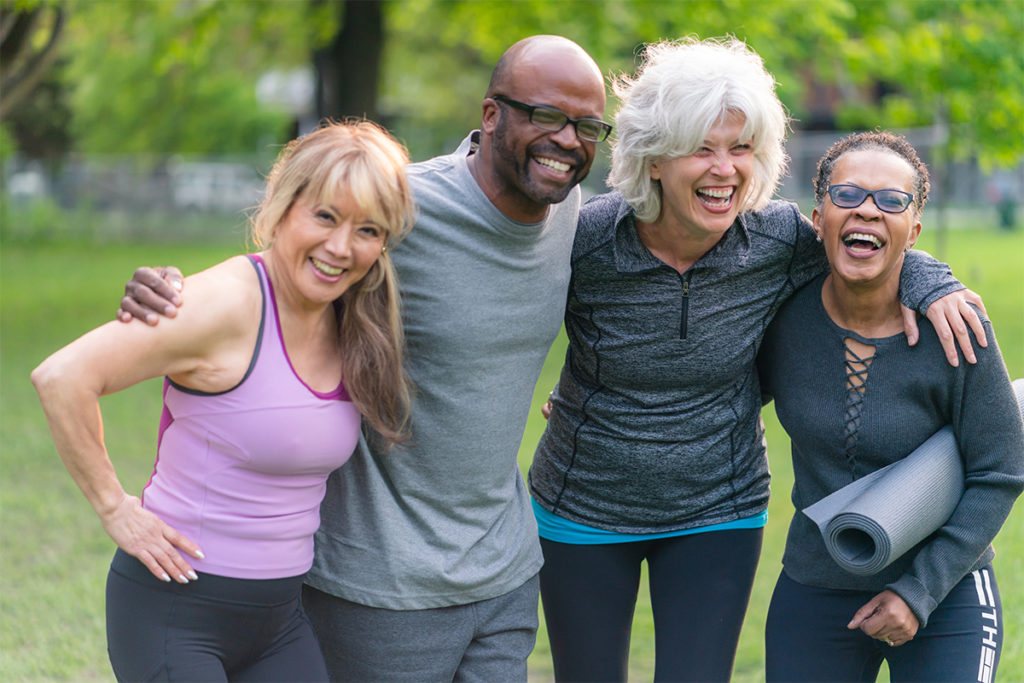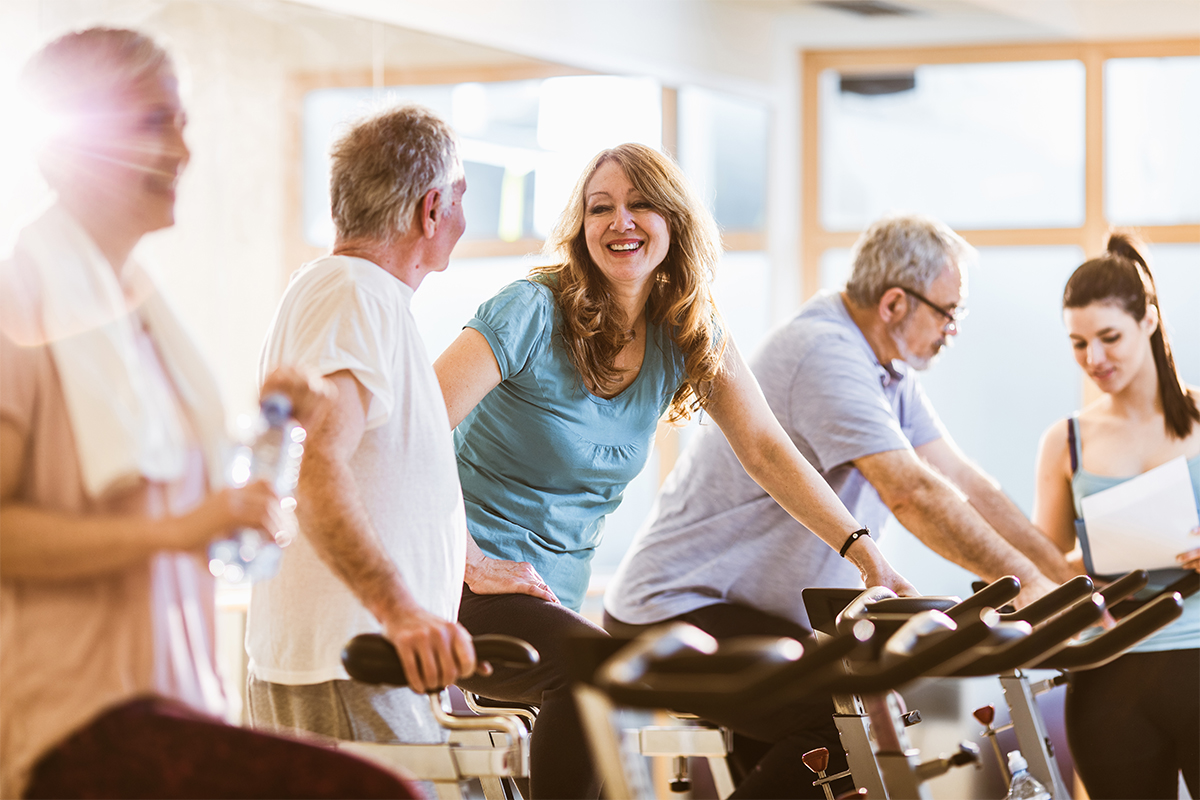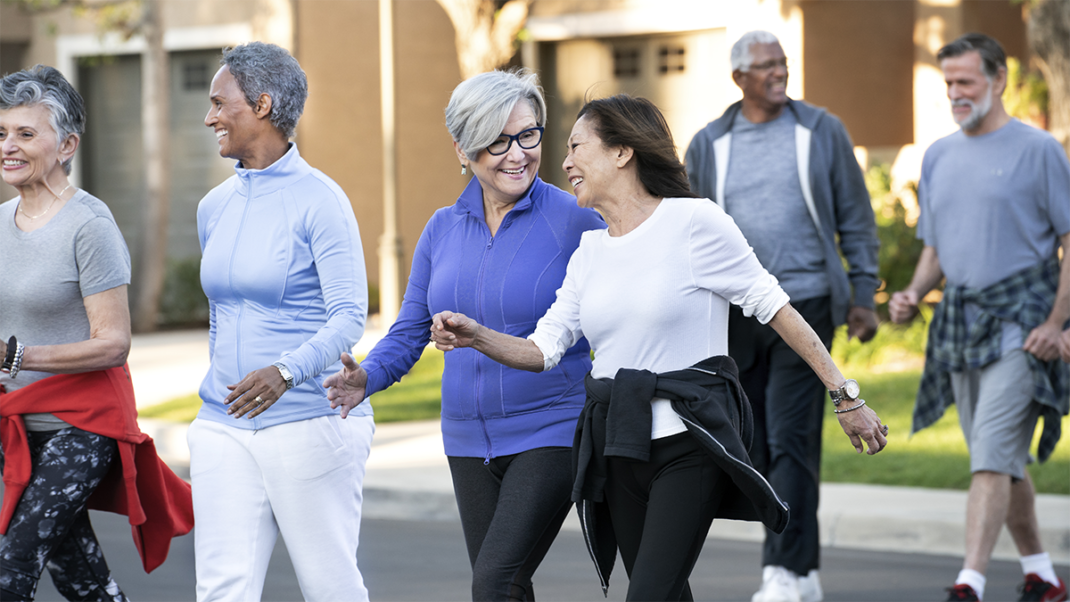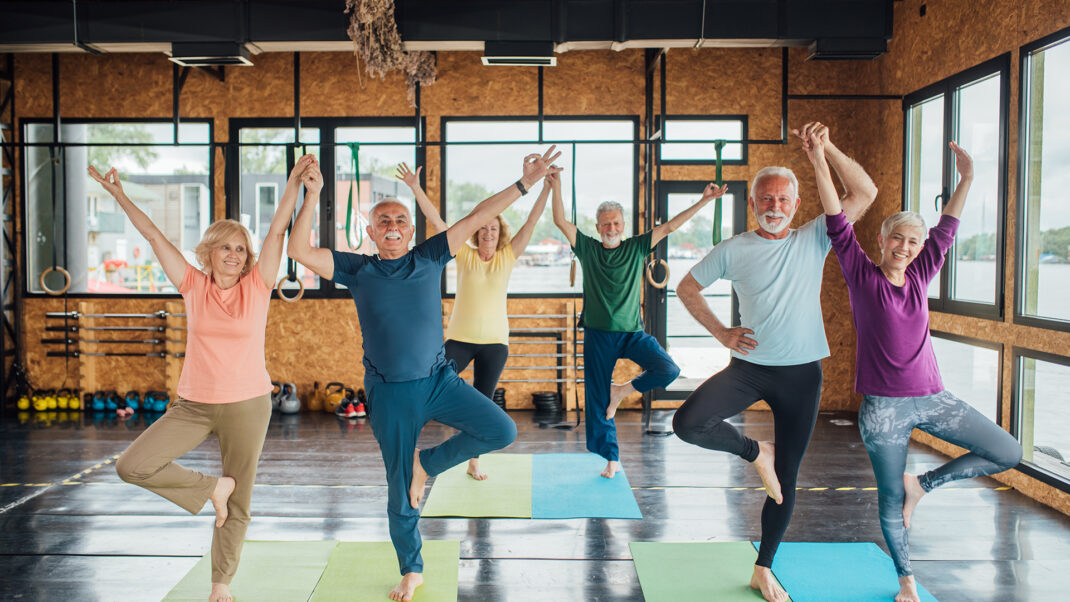The Benefits of Social Connections in Fitness
Learn how physical activity and social connection benefit the brain and improve quality of life.

After 18 months of relative isolation, rebuilding social connections is vital for you and your fitness clients. Enhancing social connectedness can significantly improve quality of life, boost health and well-being, elevate mood and happiness, increase longevity, and even enhance cognitive and physical performance (Denworth 2020). Socialization is important at any time, but the need today is greater than ever. Fortunately, your fitness sessions can help to meet the demand!
Discover more about socialization’s advantages and how you can make them more available to your clients.
Social Connections and Neuroplasticity
Social neuroscience researchers are finding that increased connectedness benefits us, partly, by stimulating neuroplasticity, the rewiring of our brain cells. Greater neuroplasticity improves cognitive and physical performance as well as overall health (Gupta 2007; Levintin 2020).
In a nutshell, here’s how it works: Socializing activates neurotransmitter substances that allow brain cells to communicate with each other, fostering greater neuroplasticity. This effect triggers the release of hormones into the bloodstream, and they, in turn, activate cells throughout the body (Denworth 2020). Learning something challenging and new has a similar effect.
Just as brain neuroplasticity ultimately enhances physical well-being, so the reverse is true: Physical exercise improves brain function. This synergistic body-mind connection operates throughout our lives.
For more on neuroplasticity, see “Socializing, Learning and Exercise Benefit the Brain,” below.
See also: The Power of Connection in the Age of Social Distancing
The Benefits of Social Connections

Providing clients with opportunities for social connections can lessen some negative health effects.
Chronic Diseases
Like physically inactive people, those less socially connected are two to three times more likely to develop chronic diseases and die prematurely (Byrne & Syme 1979; McGonigal 2007). Social connectedness helps protect against heart attack and stroke, strengthens the immune system, and supports long-term health (Denworth 2020; Renken 2020). Simply having another person to socialize with effectively reduces heart rate, blood pressure and stress-related hormones (Holt-Lunstadt, Robles & Sbarra 2017).
The effects of chronic disease can begin as much as 10–20 years before symptoms appear (Beason–Held et al. 2013). By providing clients and group participants with opportunities to connect socially—and, of course, to exercise!—fitness professionals can lessen these effects.
Brain Health and Mental Well-Being
Reviewing the neuroscience research, Mintzer and colleagues (2019) found that greater social connectedness enlarges hippocampal brain volume, improving memory and overall brain health. Loneliness, they discovered, can exasperate social and mental problems. In one study, Mintzer noted that individuals with stronger social connections possessed better brain health than those in a control group.
Cognitive Decline and Dementia
Social connectedness can reduce the risk of cognitive decline, including Alzheimer’s disease and dementia. Researchers have found that those with greater social connectedness had greater brain volume (which declines with age) than those with fewer social connections (Bickart et al 2011; Powell et al 2012). Additionally, it has been found that adhering to healthy lifestyle choices, including socialization, across the life span can prevent more than 30% of cases of dementia (Livingston et al. 2017).
Stress
Stress can decrease significantly with greater socialization, says neurosurgeon Sanjay Gupta (Gupta & Loberg 2021). Stressful situations increase the production of cortisol, which is linked to cognitive impairment and decreased hippocampal volume (Mintzer et al. 2019). Cortisol breaks down muscle protein to make sugar available to muscles for energy, fueling the fight-or-flight response. Unalleviated stress leads to muscle deterioration and loss of muscle mass. Stress has also been found to weaken the immune system and shorten telomeres, the protective molecular substances on the ends of our chromosomes (Chopra & Tanzi 2015).
Mood and Happiness
Greater socialization can ease depression and has been shown to improve mood and increase happiness (Begley 2007; Gupta & Loberg 2021). As we age, social connections often dwindle, increasing loneliness and cognitive decline (Mintzer et al. 2019).
Telomeres and Mitochondria
Enhancing social connectedness can lengthen telomeres, ensuring that they continue to function effectively. During cell division, healthy telomeres prevent fraying—they act like “aglets,” the plastic caps on the ends of shoelaces. After numerous cell divisions, though, telomeres may become too short to protect our chromosomes, allowing cells to wither and die. Cellular death can increase the chances for chronic disease to develop, reducing life expectancy (Mitteldorf & Sagan 2016).
Mitochondria, the power plants in our cells, provide energy for working muscles. These energy generators can be damaged by stress and by free radicals associated with unhealthy lifestyle choices. Mitochondria multiply and become more robust with exercise, but they decline with age in sedentary people. When mitochondria die, cells die, too. Mitochondria benefit not only from exercise but from other epigenetic factors like socialization, which in turn boost cellular health.
Longevity
With greater social connectedness comes increased longevity (Denworth 2020). Berkman & Syme (1979) found that socially isolated people were more than twice as likely to die over a 9-year period as those who were more connected.
Unfortunately, loneliness is increasingly prevalent among the elderly—and has been acutely so during the pandemic. The health risks of loneliness can be as deadly as those from cigarette smoking (Denworth 2020) You can help by offering senior fitness classes with built-in chances for people to connect with one another (see “Fostering Social Connection Among Your Clients,” below).
Physical Performance
The human brain evolved over time to orchestrate physical activity. Consequently, improvements in cognitive function lead to enhancements in physical performance. Moreover, as noted previously, the benefits flow in both directions: Improving physical performance likewise enhances brain function.
Greater socialization throughout a lifetime facilitates the bidirectional influences of mind-body connection (Grafton 2020).
See also: Cycling Class Connection
Healthy Mind, Healthy Body
Our brains love socializing, and as human beings we benefit both cognitively and physically from exercising with others. Fitness professionals can therefore be of singular service, offering leadership for client-centered health and wellness programs that enhance the rewards of social connection while keeping our bodies vital and strong.
Socializing, Learning and Exercise Benefit the Brain
In the 1970s, Nobel Prize–winning neuroscientist Eric Kandel and his colleagues proved definitively that our neurons are physically and chemically altered when we socialize or learn something new (Carr 2010).
In fact, the more we socialize, the more we stimulate neuroplasticity, according to neuroscientist Lisa Feldman Barrett. Activating neuroplasticity throughout a lifetime, she suggests, is necessary, since little-used neuronal circuitry can wither if not used regularly. Feldman Barrett calls this lifelong process of strengthening or weakening neuronal circuits “tuning and pruning” (Feldman Barrett 2020).
Neuroplasticity also gets a boost from neurogenesis, the process whereby stem cells from the brain’s hippocampus migrate to all regions of the brain. Socializing, learning and exercise all stimulate neurogenesis. Hippocampal stem cells join existing neural circuits, replacing worn-out cells or strengthening existing circuits. It’s estimated that the hippocampus generates 500–1,000 stem cells daily throughout a lifetime (Begley 2007).
Fostering Social Connection Among Your Clients
As a fitness professional, you can give clients valuable opportunities for social connection, making it easier for people to choose healthy lifestyle options such as exercise, good nutrition, stress reduction and adequate sleep. Note that group exercise in itself may reduce loneliness in older adults (Archer 2021).
These 10 tips can enhance social connectedness in all age groups. It’s best to combine multiple strategies:
- Periodically remind clients about the benefits of social connectedness and the many ways to enhance it. Health and fitness facilities provide ideal situations for boosting socialization.
- Incorporate plans for group-centered activities that encourage social connectedness and are also physically challenging.
- Plan group discussions during cooldown periods. Goal-setting for groups is best done following exercise. Experiment with moving away from the instructor-led model and letting participants own the discussion.
- Provide time and space for informal socializing. Multigenerational groups enjoy board games, for example, which challenge the brain and offer great socialization, enhancing neuroplasticity (Mosconi 2018).
- Engage senior clients, in particular, about loneliness. If it appears to be a concern, offer support and suggestions.
- Encourage clients to establish closer ties with family and friends. Urge them to stay in touch by calling or through social media (Gupta & Lopez 2021). Also, encourage friends and family members to exercise together!
- Offer multigenerational exercise classes. Clients are typically grouped according to ability levels, but make room on the schedule for multigenerational groupings, placing older and younger participants together in activities they enjoy.
- Establish multigenerational mindful meditation sessions. According to meditation expert Jon Kabat-Zinn, PhD, neuroplasticity is enhanced through mindful meditation, sharpening our ability to focus and improving our conversational listening skills. Compassion and empathy also result from meditation practice (Kabat-Zinn 2018).
- Encourage clients to engage in the creative arts. Painting, sculpture, music and dance offer socialization through enjoyable activities that can be both physically and cognitively challenging.
Suggest that your clients engage in volunteer activities. For example, AARP sponsors a reading program that pairs seniors with young children who require tutoring—a beneficial arrangement for everyone involved (Gupta & Loberg 2021).
References
Beason-Held, et al. 2013. Changes in brain function occur years before the onset of cognitive impairment. Journal of Neuroscience, 33, 18008–14. 10.1523/JNEUROSCI.1402-13.2013
Begley, S. 2007. Train Your Mind, Change Your Brain. New York: Ballentine Books.
Berkman, L.F., & Syme, S.L. 1979. Social networks, host resistance, and mortality: a nine-year follow-up study of Alameda County residents. American Journal of Epidemiology, 109 (2), 186–204. doi:10.1093/oxfordjournals.aje.a112674.
Bickart, K.C., et al. 2011. Amygdala volume and social network size in humans. Nature Neuroscience, 14 (2), 163-4.
Carr, N. 2010. The Shallows. New York: W.W. Norton and Company.
Cattaneo, G., et al. 2018. The Barcelona Brain Health Initiative: A cohort study to define and promote determinants of brain health. Frontiers of Aging Neuroscience, 10 (321).
Chopra, D., & Tanzi, R.E. 2015. Super Genes. New York: Harmony Books.
Denworth, L. 2020. Friendship. New York: W.W. Norton and Co.
Feldman Barrett, L. 2020. 7-1/2 Lessons About the Brain. New York: Houghton Mifflin Harcourt.
Grafton, S. 2020. Physical Intelligence. New York: Pantheon Books.
Gupta, S. 2007. Chasing Life. New York: Warner Wellness.
Gupta, S., & Loberg, K. 2021. Keep Sharp. New York: Simon and Schuster.
Holt-Lunstad, J., Robles, T., & Sbarrra, D.A. 2017. Advancing social connection as a public health priority in the United States. American Psychologist, 72 (6), 517–30.
Kabat-Zinn, J. 2018. Meditation Is Not What You Think. New York: Hachette Book Group.
Levintin, D.J. 2020. Successful Aging New York: Dutton.
McGonigal, K. 2007. Facilitating fellowship. IDEA Fitness Journal. Accessed June 29, 2021: ideafit.com/group-fitness/blank-70/.
Livingston, G., et al. 2017. Dementia prevention, intervention, and care. Lancet, 390, 2673–2734. 10.1016/S0140-6736(17)31363-6.
Mintzer, J, et al. 2019. Lifestyle choices and brain health. Frontiers in Medicine, 6 (204).
Mitteldorf, J., & Sagan, D. 2016. Cracking the Aging Code. New York: St. Martin’s Press.
Mosconi, L. 2018. Brain Food. New York: Avery.
Powell, J., et al. 2012. Orbital prefrontal cortex volume predicts social network size: an imaging study of individual differences in humans. Proceedings. Biological Sciences/The Royal Society, 279 (1736), 2157–62.
Renken, E. 2020. Survival of the friendliest: How our close friendships help us thrive. npr.org/sections/health-shots/2020/02/22/807742275/survival-of-the-friendliest-how-our-close-friendships-help-us-thrive.
Richard Eastwick, MEd
Richard Eastwick, MEd, taught health and physical education for 38 years and is now a personal trainer and subject matter expert certified through ACE. He peer-reviews health and fitness texts for Human Kinetics Publishing. Reach him at rich [email protected].





